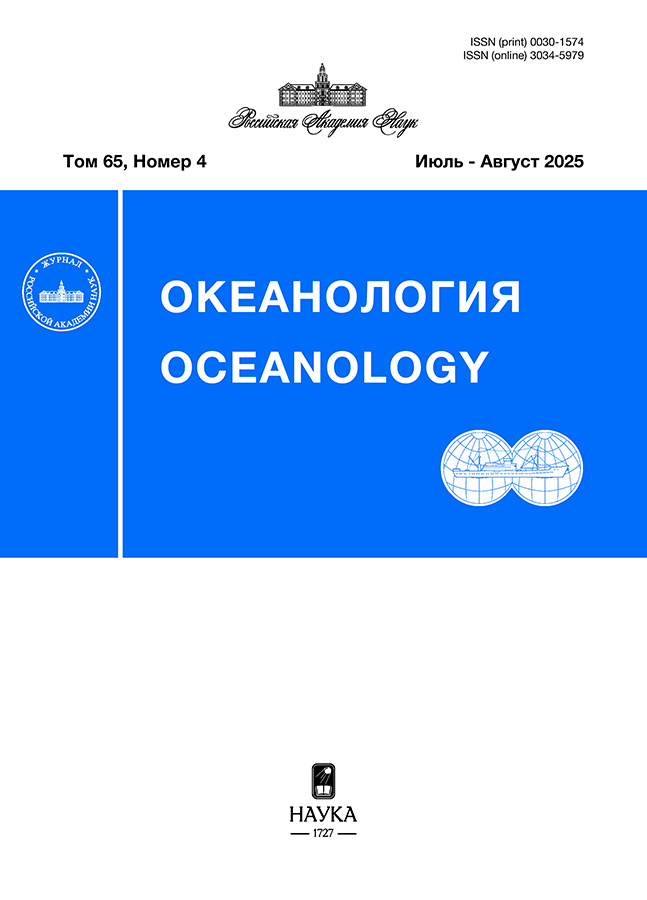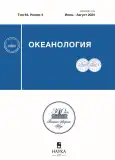Предварительные данные о влиянии глубины на таксоцен нематод в Восточно-Сибирском море
- Авторы: Портнова Д.А.1, Гарлицкая Л.А.1
-
Учреждения:
- Институт океанологии им. П.П. Ширшова РАН
- Выпуск: Том 64, № 4 (2024)
- Страницы: 597-604
- Раздел: Морская биология
- URL: https://journal-vniispk.ru/0030-1574/article/view/280457
- DOI: https://doi.org/10.31857/S0030157424040048
- EDN: https://elibrary.ru/PRWMMT
- ID: 280457
Цитировать
Полный текст
Аннотация
Структура таксоцена нематод Восточно-Сибирского моря исследовадась в рейсе ARA10C на НИС “Араон” в 2019 г. Материал был собран на разрезе от района внутреннего шельфа, от глубины 43 м, по склону до 1350 м. Таксономический состав сообщества нематод типичен для сибирских арктических морей в летне-осенний сезон. Установлено невысокое видовое разнообразия нематод по сравнению с другими морями российской Арктики. Были выделены роды, характерные для шельфа и для глубоководья. Плотность нематод в самом верхнем слое осадка увеличивается при движении с юга по шельфу, достигая максимальных значений на внешнем шельфе, уменьшаясь ниже по склону и достигая минимума в самой глубокой точке сбора. Выдвинуто предположение, что высокая численность и разнообразие нематод на внешнем шельфе обеспечивается высокими потоками органического вещества на границе водных масс, увеличивающими содержание кислорода и ила в осадке.
Ключевые слова
Об авторах
Д. А. Портнова
Институт океанологии им. П.П. Ширшова РАН
Автор, ответственный за переписку.
Email: daria.portnova@gmail.com
Россия, Москва
Л. А. Гарлицкая
Институт океанологии им. П.П. Ширшова РАН
Email: daria.portnova@gmail.com
Россия, Москва
Список литературы
- Анисимова Н.В., Фродова Е.А., Любин П.А. и др. Видовой состав и количественное распределение макробентоса в районе желоба Воронина и на прилегающей части континентального склона // Фауна беспозвоночных Карского, Баренцева и Белого морей. Мурманск: ММБИ, 2003. С. 79–92.
- Гальцова В.В., Лукина Т.Г., Владимиров М.В. Мейобентос Чаунской Губы, Восточно-Сибирское море // Исследования фауны морей. 1994. Т. 48 (56). С. 67–97.
- Голиков А.Н., Скарлато О.А., Аверинцев В.Г и др. Экосистемы Новосибирского мелководья и некоторые закономерности их распределения и функционирования // Исследования фауны морей. 1990. Т. 37 (45). С. 4–79.
- Голиков А.Н., Гагаев С.Ю., Гальцова В.В. и др. Экосистемы, флора и фауна Чаунской губы Восточно-Сибирского моря // Исследования фауны морей. 1994. Т. 47 (55). С. 4–111.
- Демидов А.Б., Гагарин В.И. Первичная продукция и условия ее формирования в Восточно-Сибирском море в осенний период // Докл. РАН. 2019. Т. 487. № 6. С. 696–700.
- Мокиевский В.О., Удалов А.А., Азовский А.И. О количественном распределении мейобентоса глубоководных зон Мирового океана // Океанология. 2007. Т. 47. № 6. С. 857–874.
- Сиренко Б.И., Денисекно С.Г. Фауна беспозвоночных Восточно-Сибирского моря, закономерности распределения и структура донных сообществ // Исследования фауны морей. 2010. Т. 66 (74). С. 160–177.
- Суханова, И.Н., Флинт М.В., Федоров А.В. и др. Первые данные о структуре фитопланктонах сообщества Восточно-Сибирского моря // Океанология. 2021. Т. 61. № 6. С. 936–957.
- Шереметьевский А.М. Роль мейобентоса в биоценозах шельфа // Исследования фауны морей. 1987. Т. 35 (43). С. 3–136.
- Anderson L.G., Björk G., Jutterström S. et al. East Siberian Sea, an Arctic region of very high biogeochemical activity // Biogeosciences. 2011. V. 8. Iss. 6. P. 4–6.
- Barber D.G., Massom R.A. The role of sea ice in Arctic and Antarctic polynyas // Oceanography Series. 2007. V. 74. P. 1–54.
- Boucher G., Lambshead P.J.D. Ecological biodiversity of marine nematodes in samples from temperate, tropical and deep-sea regions // Conservation Biology. 1995. V. 9. P. 1594–1604.
- Broman E., Bonaglia S., Holovachov O. et al. Uncovering diversity and metabolic spectrum of animals in dead zone sediments // Communications biology. 2020. V. 3 (1). P. 106.
- Danovaro R., Bianchelli S., Gambi C. et al. α-, β-, γ-, δ- and ε-diversity of deep-sea nematodes in canyons and open slopes of Northeast Atlantic and Mediterranean margins // Marine Ecology Progress Series. 2009. V. 396. P. 197–209.
- Derycke S., Remerie T., Backeljau T. et al. Phylogeography of the Rhabditis (Pellioditis) marina species complex: evidence for long-distance dispersal, and for range expansions and restricted gene flow in the northeast Atlantic // Molecular Ecology. 2008. V. 17. P. 3306–3322.
- Dmitrenko I.A., Kirillov S.A., Tremblay L.B. et al. Impact of the Arctic Ocean Atlantic water layer on Siberian shelf hydrography // Journal of Geophysical Research: Oceans. 2010. V. 115. № C8.
- Fonseca G., Soltwedel T. Deep-sea meiobenthic communities underneath the marginal ice zone off Eastern Greenland // Polar Biology. 2007. V. 30. P. 607–618.
- Fonseca G., Soltwedel T. Regional patterns of nematode assemblages in the Arctic deep seas // Polar Biology. 2009. V. 32. P. 1345–1357.
- Hammer Ø., Harper D.A.T., Ryan P.D. PAST paleontological statistics software package for education and data analysis // Palaeontology Electron. 2001. V. 4. P. 1–9.
- Huang Y., Zhang Z. A new genus and three new species of free-living marine nematodes (Nematoda: Enoplida: Enchelidiidae) from the Yellow Sea, China. CBM–Cahiers de Biologie Marine. 2004. V. 45. P. 343–354.
- Jørgensen L.L., Pearson T.H., Anisimova N.A. et al. Environmental influences on benthic fauna associations of the Kara Sea (Arctic Russia) // Polar Biology. 1999. V. 22 (6). P. 395–416.
- Holme N.A., McIntyre A.D. Methods for the study of marine benthos. Oxford: Blackwell Scientific Publication, 1984. 387 p.
- Miljutin D.M., Gad G., Miljutina M.A. et al. The state of knowledge on deep-sea nematode taxonomy: how many valid species are known down there? // Marine Biodiversity. 2010. V. 40. P. 143–159.
- Moens T., Braeckman U., Derycke S. et al. Ecology of free-living marine nematodes // Nematoda. 2013. V. 2. P. 109–152.
- Mureşan M. Assessment of free-living marine nematodes community from the NW Romanian Black Sea shelf // Geo Ecology Marine. 2012. V. 18. P. 133–145.
- Muthumbi A.W., Vincx M. Acantholaimus (Chromadoridae: Nematoda) from the Indian Ocean: description of seven species // Hydrobiologia. 1997. V. 346. P. 59–76.
- Netto S.A., Attrill M.J., Warwick R.M. Sublittoral meiofauna and macro-fauna of Rocas Atoll (NE Brazil): indirect evidence of a topographically controlled front // Marine Ecology Progress Series. 1999. V. 179. P. 175–186.
- Piepenburg D., Schmid M. A photographic survey of the epibenthic megafauna of the Arctic Laptev Sea shelf: distribution, abundance, and estimates of biomass and organic carbon demand // Marine Ecology Progress Series. 1997. V. 147. P. 63–75.
- Platonova T.A., Kulangieva L.V. Marine Enoplida from the East Siberian Sea (Nematoda) // Zoosystematica Rossica, 1995. V. 3 (2). P. 175–180.
- Portnova D.A., Garlitska L.A., Polukhin A.A. The effect of estuarine system on the meiofauna and nematodes in the East Siberian Sea // Scientific Reports. 2021. V. 11 (1). P. 19306.
- Portnova D., Fedyaeva M.A., Udalov A.A., Tchesunov A.V. Community structure of nematodes in the Laptev Sea shelf with notes on the lives of ice nematodes // Regional Studies in Marine Science. 2019. V. 31. P. 100757.
- Portnova D., Polukhin A. Meiobenthos of the eastern shelf of the Kara Sea compared with the meiobenthos of other parts of the sea // Regional Studies in Marine Science. 2018. V. 24. P. 370–378.
- Savvichev A.S., Kadnikov V.V., Kravchishina M.D. et al. Methane as an organic matter source and the trophic basis of a Laptev Sea cold seep microbial community // Geomicrobiology. 2018. V. 35 (5). P. 411–423.
- Semiletov I., Dudarev O., Luchin V. et al. The East Siberian Sea as a transition zone between Pacific-derived waters and Arctic shelf waters // Geophysical Research Letters. 2005. V. 32 (10).
- Soetaert K., Heip C. Nematode assemblages of deep sea and shelf break sites in the North Atlantic and Mediterranean Sea // Marine Ecology Progress Series. 1995. V. 125. P. 171–183.
- Stein R., Macdonald R.W. Organic carbon budget: Arctic Ocean vs. global ocean // The Organic Carbon Cycle in the Arctic Ocean. 2004. P. 315–322.
- Udalov A., Chikina M., Azovsky A. et al. Integrity of benthic assemblages along the arctic estuarine-coastal system // Ecological Indicators. 2021. V. 121. P. 107115.
- Vanaverbeke J., Arbizu P.M., Dahms H.U., Schmink H.K. The metazoan meiobenthos along a depth gradient in the Arctic Laptev Sea with special attention to nematode communities // Polar Biology. 1997. V. 18 (6). P. 391–401.
- Vanaverbeke J., Merckx B., Degraer S., Vincx M. Sediment-related distribution patterns of nematodes and macrofauna: two sides of the benthic coin? // Marine Environmental Research. 2011. V. 71 (1). P. 31–40.
- Vedenin A.A., Galkin S.V., Kozlovsky V.V. Macrobenthos of the Ob Bay and adjacent Kara Sea shelf // Polar Biology. 2015. V. 38. P. 829–844.
- Wang X., Zhao J., Lobanov V.B. et al. Distribution and transport of water masses in the East Siberian Sea and their impacts on the Arctic halocline // Journal of Geophysical Research: Oceans. 2021. V. 126 (8). P. e2020JC016523.
Дополнительные файлы










